Supplier Scorecard: Evaluating and Selecting Suppliers in Supply Chain
VerifiedAdded on 2023/04/23
|6
|1095
|313
Report
AI Summary
This report provides an overview of supplier scorecards and their importance in supply chain management. It discusses the weighted-criteria evaluation system for supplier selection, highlighting key dimensions like quality, delivery, technology, risk, cost, responsiveness, and market value. The weighted-point method is favored for its reliability and inclusion of both qualitative and quantitative factors. An example supplier scorecard for ABC Company is provided, illustrating the measurement of different performance metrics and the calculation of an overall score. The document also includes a bibliography of relevant sources. Desklib offers more solved assignments and resources for students.

1
Supply Chain
Supply Chain
Paraphrase This Document
Need a fresh take? Get an instant paraphrase of this document with our AI Paraphraser
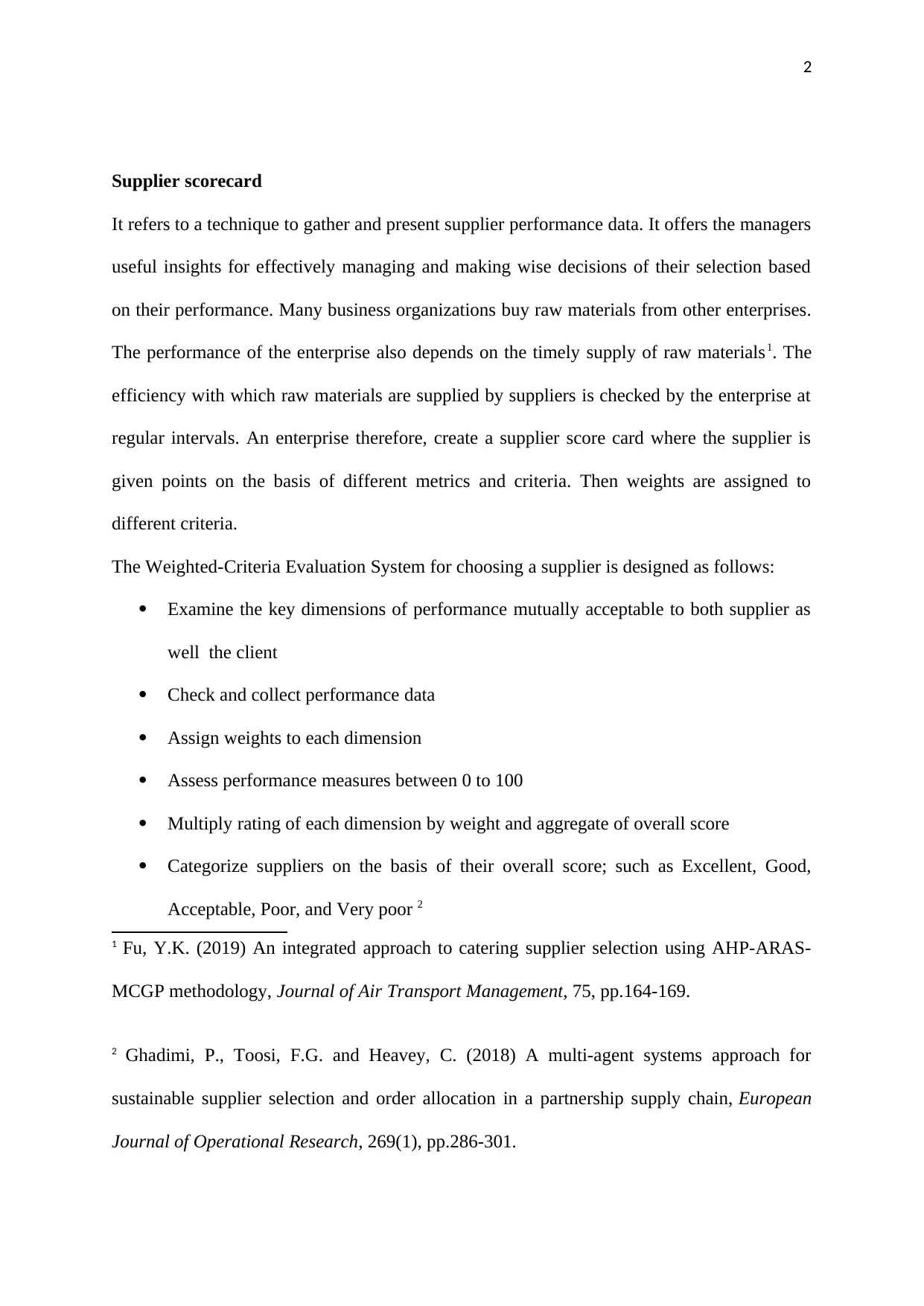
2
Supplier scorecard
It refers to a technique to gather and present supplier performance data. It offers the managers
useful insights for effectively managing and making wise decisions of their selection based
on their performance. Many business organizations buy raw materials from other enterprises.
The performance of the enterprise also depends on the timely supply of raw materials1. The
efficiency with which raw materials are supplied by suppliers is checked by the enterprise at
regular intervals. An enterprise therefore, create a supplier score card where the supplier is
given points on the basis of different metrics and criteria. Then weights are assigned to
different criteria.
The Weighted-Criteria Evaluation System for choosing a supplier is designed as follows:
Examine the key dimensions of performance mutually acceptable to both supplier as
well the client
Check and collect performance data
Assign weights to each dimension
Assess performance measures between 0 to 100
Multiply rating of each dimension by weight and aggregate of overall score
Categorize suppliers on the basis of their overall score; such as Excellent, Good,
Acceptable, Poor, and Very poor 2
1 Fu, Y.K. (2019) An integrated approach to catering supplier selection using AHP-ARAS-
MCGP methodology, Journal of Air Transport Management, 75, pp.164-169.
2 Ghadimi, P., Toosi, F.G. and Heavey, C. (2018) A multi-agent systems approach for
sustainable supplier selection and order allocation in a partnership supply chain, European
Journal of Operational Research, 269(1), pp.286-301.
Supplier scorecard
It refers to a technique to gather and present supplier performance data. It offers the managers
useful insights for effectively managing and making wise decisions of their selection based
on their performance. Many business organizations buy raw materials from other enterprises.
The performance of the enterprise also depends on the timely supply of raw materials1. The
efficiency with which raw materials are supplied by suppliers is checked by the enterprise at
regular intervals. An enterprise therefore, create a supplier score card where the supplier is
given points on the basis of different metrics and criteria. Then weights are assigned to
different criteria.
The Weighted-Criteria Evaluation System for choosing a supplier is designed as follows:
Examine the key dimensions of performance mutually acceptable to both supplier as
well the client
Check and collect performance data
Assign weights to each dimension
Assess performance measures between 0 to 100
Multiply rating of each dimension by weight and aggregate of overall score
Categorize suppliers on the basis of their overall score; such as Excellent, Good,
Acceptable, Poor, and Very poor 2
1 Fu, Y.K. (2019) An integrated approach to catering supplier selection using AHP-ARAS-
MCGP methodology, Journal of Air Transport Management, 75, pp.164-169.
2 Ghadimi, P., Toosi, F.G. and Heavey, C. (2018) A multi-agent systems approach for
sustainable supplier selection and order allocation in a partnership supply chain, European
Journal of Operational Research, 269(1), pp.286-301.
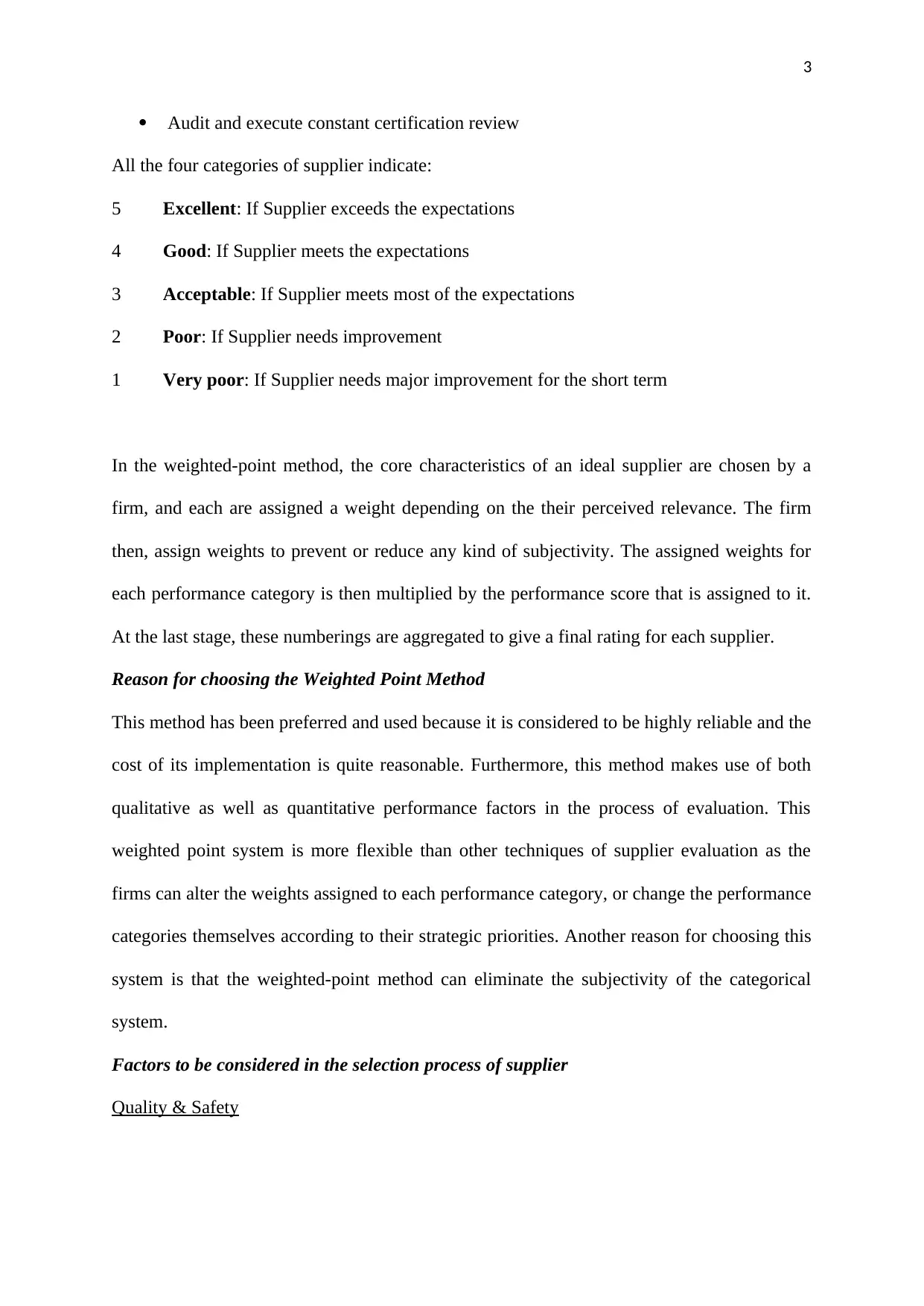
3
Audit and execute constant certification review
All the four categories of supplier indicate:
5 Excellent: If Supplier exceeds the expectations
4 Good: If Supplier meets the expectations
3 Acceptable: If Supplier meets most of the expectations
2 Poor: If Supplier needs improvement
1 Very poor: If Supplier needs major improvement for the short term
In the weighted-point method, the core characteristics of an ideal supplier are chosen by a
firm, and each are assigned a weight depending on the their perceived relevance. The firm
then, assign weights to prevent or reduce any kind of subjectivity. The assigned weights for
each performance category is then multiplied by the performance score that is assigned to it.
At the last stage, these numberings are aggregated to give a final rating for each supplier.
Reason for choosing the Weighted Point Method
This method has been preferred and used because it is considered to be highly reliable and the
cost of its implementation is quite reasonable. Furthermore, this method makes use of both
qualitative as well as quantitative performance factors in the process of evaluation. This
weighted point system is more flexible than other techniques of supplier evaluation as the
firms can alter the weights assigned to each performance category, or change the performance
categories themselves according to their strategic priorities. Another reason for choosing this
system is that the weighted-point method can eliminate the subjectivity of the categorical
system.
Factors to be considered in the selection process of supplier
Quality & Safety
Audit and execute constant certification review
All the four categories of supplier indicate:
5 Excellent: If Supplier exceeds the expectations
4 Good: If Supplier meets the expectations
3 Acceptable: If Supplier meets most of the expectations
2 Poor: If Supplier needs improvement
1 Very poor: If Supplier needs major improvement for the short term
In the weighted-point method, the core characteristics of an ideal supplier are chosen by a
firm, and each are assigned a weight depending on the their perceived relevance. The firm
then, assign weights to prevent or reduce any kind of subjectivity. The assigned weights for
each performance category is then multiplied by the performance score that is assigned to it.
At the last stage, these numberings are aggregated to give a final rating for each supplier.
Reason for choosing the Weighted Point Method
This method has been preferred and used because it is considered to be highly reliable and the
cost of its implementation is quite reasonable. Furthermore, this method makes use of both
qualitative as well as quantitative performance factors in the process of evaluation. This
weighted point system is more flexible than other techniques of supplier evaluation as the
firms can alter the weights assigned to each performance category, or change the performance
categories themselves according to their strategic priorities. Another reason for choosing this
system is that the weighted-point method can eliminate the subjectivity of the categorical
system.
Factors to be considered in the selection process of supplier
Quality & Safety
⊘ This is a preview!⊘
Do you want full access?
Subscribe today to unlock all pages.

Trusted by 1+ million students worldwide
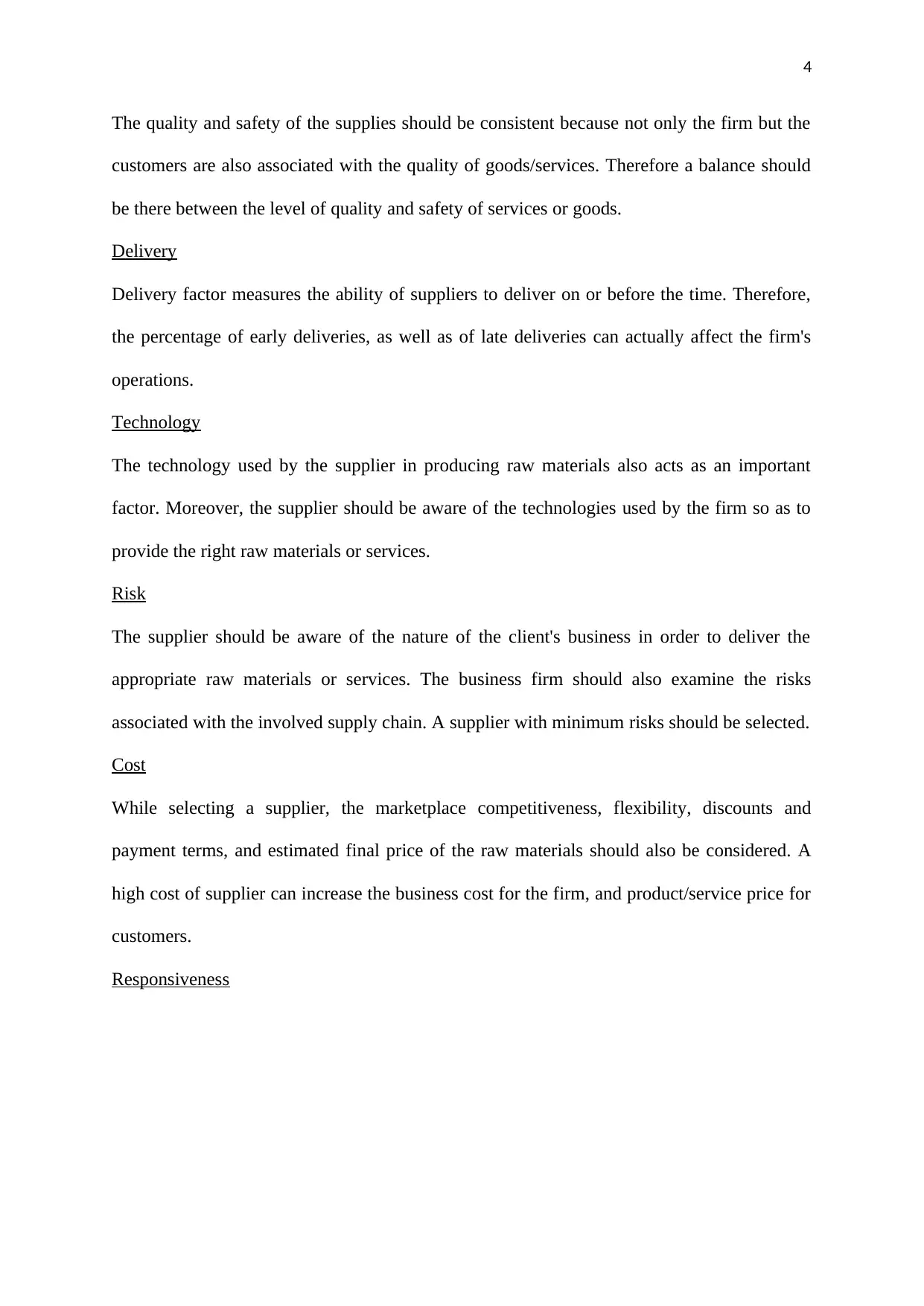
4
The quality and safety of the supplies should be consistent because not only the firm but the
customers are also associated with the quality of goods/services. Therefore a balance should
be there between the level of quality and safety of services or goods.
Delivery
Delivery factor measures the ability of suppliers to deliver on or before the time. Therefore,
the percentage of early deliveries, as well as of late deliveries can actually affect the firm's
operations.
Technology
The technology used by the supplier in producing raw materials also acts as an important
factor. Moreover, the supplier should be aware of the technologies used by the firm so as to
provide the right raw materials or services.
Risk
The supplier should be aware of the nature of the client's business in order to deliver the
appropriate raw materials or services. The business firm should also examine the risks
associated with the involved supply chain. A supplier with minimum risks should be selected.
Cost
While selecting a supplier, the marketplace competitiveness, flexibility, discounts and
payment terms, and estimated final price of the raw materials should also be considered. A
high cost of supplier can increase the business cost for the firm, and product/service price for
customers.
Responsiveness
The quality and safety of the supplies should be consistent because not only the firm but the
customers are also associated with the quality of goods/services. Therefore a balance should
be there between the level of quality and safety of services or goods.
Delivery
Delivery factor measures the ability of suppliers to deliver on or before the time. Therefore,
the percentage of early deliveries, as well as of late deliveries can actually affect the firm's
operations.
Technology
The technology used by the supplier in producing raw materials also acts as an important
factor. Moreover, the supplier should be aware of the technologies used by the firm so as to
provide the right raw materials or services.
Risk
The supplier should be aware of the nature of the client's business in order to deliver the
appropriate raw materials or services. The business firm should also examine the risks
associated with the involved supply chain. A supplier with minimum risks should be selected.
Cost
While selecting a supplier, the marketplace competitiveness, flexibility, discounts and
payment terms, and estimated final price of the raw materials should also be considered. A
high cost of supplier can increase the business cost for the firm, and product/service price for
customers.
Responsiveness
Paraphrase This Document
Need a fresh take? Get an instant paraphrase of this document with our AI Paraphraser
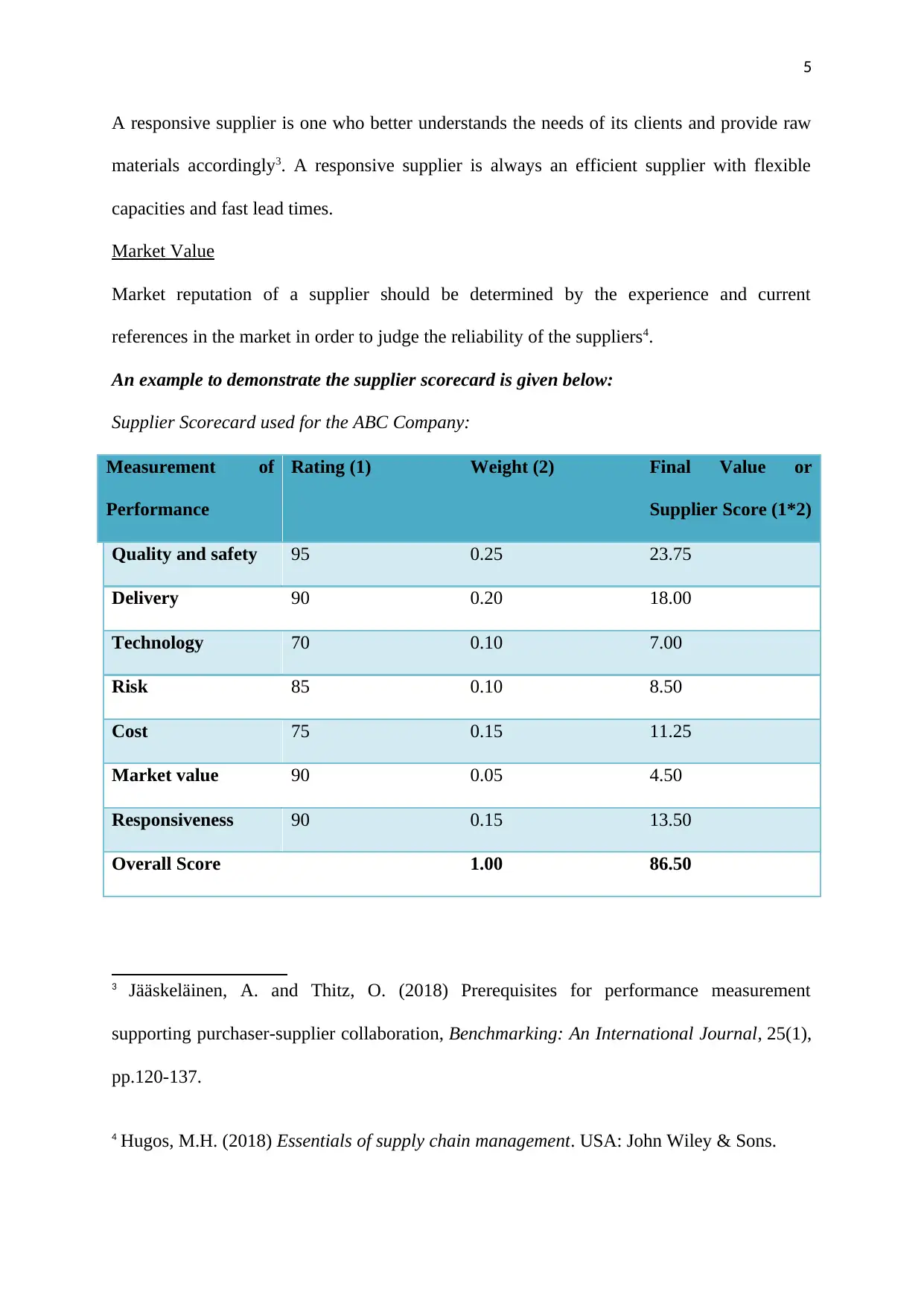
5
A responsive supplier is one who better understands the needs of its clients and provide raw
materials accordingly3. A responsive supplier is always an efficient supplier with flexible
capacities and fast lead times.
Market Value
Market reputation of a supplier should be determined by the experience and current
references in the market in order to judge the reliability of the suppliers4.
An example to demonstrate the supplier scorecard is given below:
Supplier Scorecard used for the ABC Company:
Measurement of
Performance
Rating (1) Weight (2) Final Value or
Supplier Score (1*2)
Quality and safety 95 0.25 23.75
Delivery 90 0.20 18.00
Technology 70 0.10 7.00
Risk 85 0.10 8.50
Cost 75 0.15 11.25
Market value 90 0.05 4.50
Responsiveness 90 0.15 13.50
Overall Score 1.00 86.50
3 Jääskeläinen, A. and Thitz, O. (2018) Prerequisites for performance measurement
supporting purchaser-supplier collaboration, Benchmarking: An International Journal, 25(1),
pp.120-137.
4 Hugos, M.H. (2018) Essentials of supply chain management. USA: John Wiley & Sons.
A responsive supplier is one who better understands the needs of its clients and provide raw
materials accordingly3. A responsive supplier is always an efficient supplier with flexible
capacities and fast lead times.
Market Value
Market reputation of a supplier should be determined by the experience and current
references in the market in order to judge the reliability of the suppliers4.
An example to demonstrate the supplier scorecard is given below:
Supplier Scorecard used for the ABC Company:
Measurement of
Performance
Rating (1) Weight (2) Final Value or
Supplier Score (1*2)
Quality and safety 95 0.25 23.75
Delivery 90 0.20 18.00
Technology 70 0.10 7.00
Risk 85 0.10 8.50
Cost 75 0.15 11.25
Market value 90 0.05 4.50
Responsiveness 90 0.15 13.50
Overall Score 1.00 86.50
3 Jääskeläinen, A. and Thitz, O. (2018) Prerequisites for performance measurement
supporting purchaser-supplier collaboration, Benchmarking: An International Journal, 25(1),
pp.120-137.
4 Hugos, M.H. (2018) Essentials of supply chain management. USA: John Wiley & Sons.
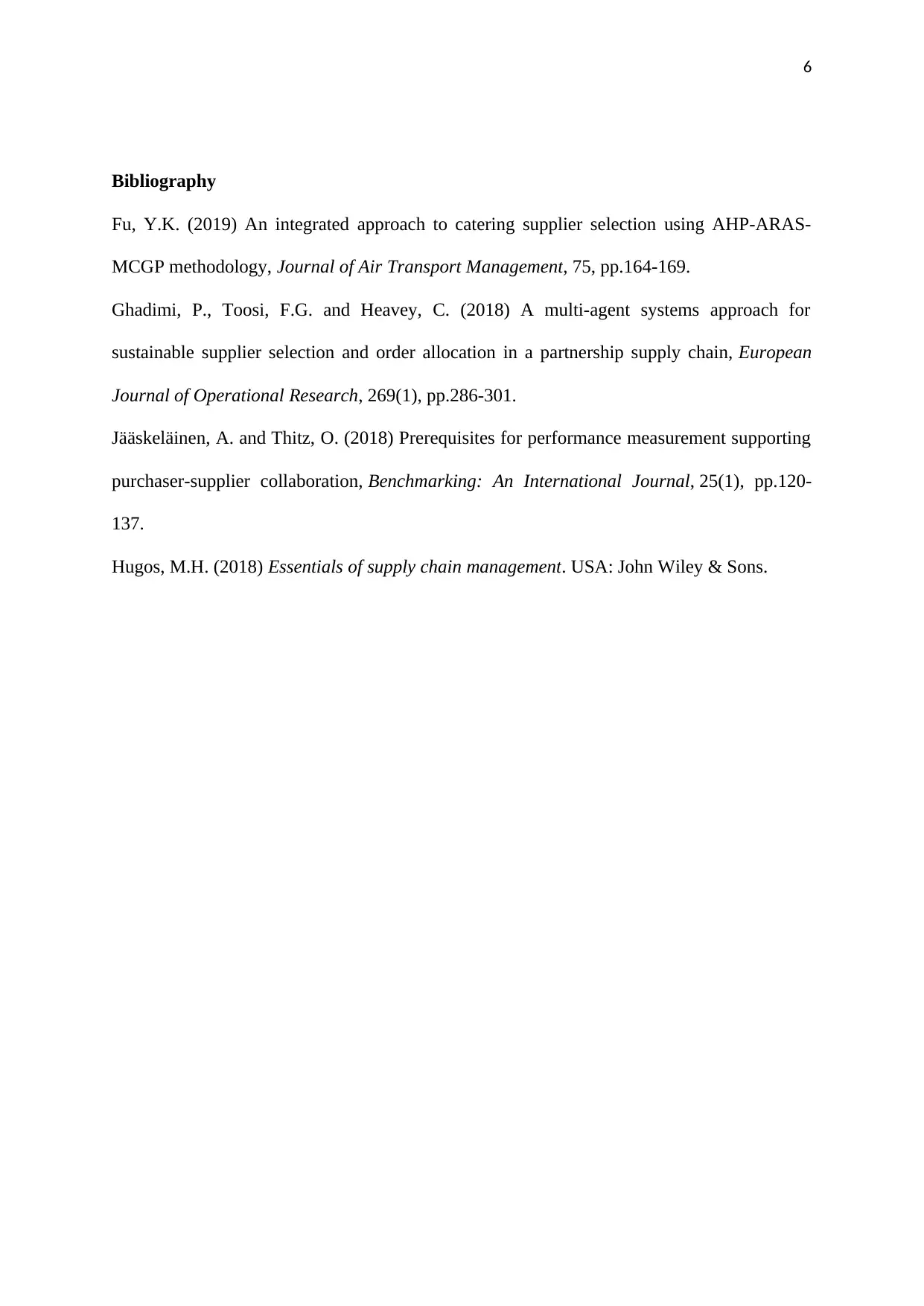
6
Bibliography
Fu, Y.K. (2019) An integrated approach to catering supplier selection using AHP-ARAS-
MCGP methodology, Journal of Air Transport Management, 75, pp.164-169.
Ghadimi, P., Toosi, F.G. and Heavey, C. (2018) A multi-agent systems approach for
sustainable supplier selection and order allocation in a partnership supply chain, European
Journal of Operational Research, 269(1), pp.286-301.
Jääskeläinen, A. and Thitz, O. (2018) Prerequisites for performance measurement supporting
purchaser-supplier collaboration, Benchmarking: An International Journal, 25(1), pp.120-
137.
Hugos, M.H. (2018) Essentials of supply chain management. USA: John Wiley & Sons.
Bibliography
Fu, Y.K. (2019) An integrated approach to catering supplier selection using AHP-ARAS-
MCGP methodology, Journal of Air Transport Management, 75, pp.164-169.
Ghadimi, P., Toosi, F.G. and Heavey, C. (2018) A multi-agent systems approach for
sustainable supplier selection and order allocation in a partnership supply chain, European
Journal of Operational Research, 269(1), pp.286-301.
Jääskeläinen, A. and Thitz, O. (2018) Prerequisites for performance measurement supporting
purchaser-supplier collaboration, Benchmarking: An International Journal, 25(1), pp.120-
137.
Hugos, M.H. (2018) Essentials of supply chain management. USA: John Wiley & Sons.
⊘ This is a preview!⊘
Do you want full access?
Subscribe today to unlock all pages.

Trusted by 1+ million students worldwide
1 out of 6
Your All-in-One AI-Powered Toolkit for Academic Success.
+13062052269
info@desklib.com
Available 24*7 on WhatsApp / Email
![[object Object]](/_next/static/media/star-bottom.7253800d.svg)
Unlock your academic potential
Copyright © 2020–2025 A2Z Services. All Rights Reserved. Developed and managed by ZUCOL.
